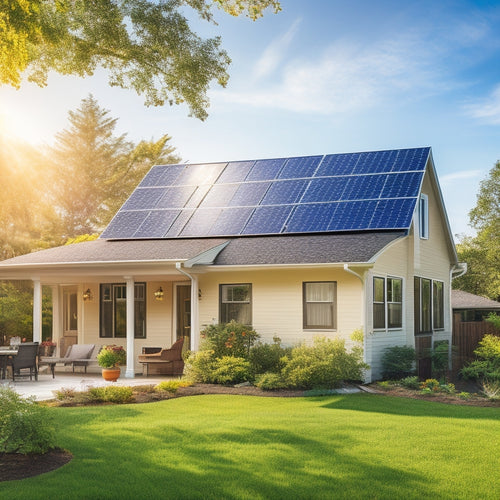
What to Know Before Installing Solar Power for Business
Share
Before installing solar power for your business, you'll want to assess your energy needs by gathering historical consumption data and identifying peak usage periods. You should also understand local financial incentives, such as federal and state rebates, and evaluate your roof's condition and structural integrity for solar panel support. Additionally, research provider options, considering factors like certifications and warranties, and investigate energy storage solutions. By doing so, you'll be well-prepared to calculate the payback period and ROI of your investment. As you digest these essential considerations, you'll uncover even more critical factors that will guarantee a successful shift to renewable energy.
Key Takeaways
- Assess your business's energy needs and consumption patterns to identify opportunities for cost reduction and optimization.
- Understand the financial incentives available, including federal and state tax credits, rebates, and deductions that can reduce installation costs.
- Ensure your roof and site are ready for solar panel installation by assessing roof condition, orientation, and shading, as well as maintenance accessibility.
- Choose a reputable solar provider with a proven track record, relevant certifications, and a range of solar panel options.
- Consider energy storage solutions and calculate the payback period and ROI using methods such as simple payback, discounted cash flow, or net present value.
Assessing Business Energy Needs
Determine your business's energy usage patterns by gathering historical energy consumption data from past utility bills or meter readings. This information will help you identify peak usage periods, which are critical for demand forecasting and optimizing your energy efficiency.
By analyzing your energy consumption patterns, you can pinpoint areas where you can reduce operational costs and align with your sustainability goals.
As you assess your business's energy needs, consider the role renewable sources can play in reducing your reliance on traditional energy providers. You'll want to evaluate how much energy your business requires during peak periods and determine the best way to meet that demand.
Reviewing your utility bills will help you understand your energy usage patterns and identify opportunities to reduce consumption. This data-driven approach will enable you to make informed decisions about your energy strategy, reducing costs and environmental impact while increasing your business's energy independence.
Understanding Local Incentives
One key benefit of investing in solar power is the various incentives available to businesses that make the switch. You'll want to understand the local incentives that apply to your business, as they can greatly reduce the cost of installation and increase your return on investment.
| Incentive Type | Description | Benefits |
|---|---|---|
| Federal Incentives | 30% tax credit for solar installations | Reduces upfront cost |
| State Rebates | Varies by state, but typically a one-time payment | Additional savings |
| Utility Programs | Net metering and renewable energy certificates | Generates revenue |
Other incentives to evaluate include grant programs, financing options, property tax exemptions, and community solar programs. These can provide additional savings, revenue streams, or low-interest financing for your solar installation. Be sure to research and take advantage of the incentives available in your area to maximize your solar investment. By understanding these local incentives, you can make a more informed decision about investing in solar power for your business.
Evaluating Roof Readiness
How will your roof accommodate a solar panel installation? Before installing solar power, you need to analyze your roof's readiness.
Start by evaluating the roof condition and structural integrity to guarantee it can support the weight of the solar panels. A thorough inspection will identify any potential issues, such as damaged or missing tiles, that need to be addressed before installation.
Next, conduct a shading analysis to determine if any obstacles, like trees or nearby buildings, will cast shadows on the panels. An orientation evaluation will also help you determine the ideal placement of the panels to maximize energy production.
Consider maintenance considerations, such as accessibility for future repairs and cleaning. Additionally, installation obstacles, like skylights or vents, should be taken into account.
You should also consider your local climate and how it may impact the solar panels' performance.
Choosing a Solar Provider
You'll want to select a solar provider that can demonstrate a proven track record of successful installations, holding relevant certifications such as NABCEP (North American Board of Certified Energy Practitioners).
The provider's experience and qualifications will greatly impact the quality of your solar panel system.
When evaluating providers, you should also consider the range of solar panel options they offer, including different efficiencies, warranties, and prices.
Experience and Qualifications
Choosing a solar provider with extensive experience and qualifications is essential to guaranteeing a successful installation that meets your business's energy needs. You want a provider that has a proven track record of providing high-quality installations that generate maximum energy output.
Look for providers with industry experience, specifically in commercial solar installations. They should have a team of experts with the necessary knowledge and skills to design and install a system that meets your business's unique energy requirements.
Check for installation certifications such as North American Board of Certified Energy Practitioners (NABCEP) certification, which verifies that the provider's installers have undergone rigorous training and testing. Additionally, review the provider's portfolio to see examples of previous commercial installations they've completed.
You should also ask about their quality control processes, warranties, and maintenance services. By doing your due diligence, you can guarantee that you're working with a reputable and experienced provider that can provide a high-quality solar installation for your business.
Solar Panel Options
Three key factors to reflect upon when evaluating solar panel options are efficiency, durability, and cost. You'll want to contemplate the type of solar panel that suits your business's needs.
-
Monocrystalline panels offer high efficiency rates (15-20%) but are more expensive.
-
Polycrystalline panels are a cost-effective alternative, with slightly lower efficiency rates (12-15%).
-
Thin film technology is a budget-friendly option, but its efficiency rates (7-14%) are considerably lower.
- Bifacial modules can increase energy output by up to 25% by utilizing light from both sides of the panel.
When choosing a solar provider, also reflect on panel warranties, installation costs, and maintenance requirements.
Aesthetic considerations, such as panel color and design, may also influence your decision.
Considering Energy Storage Options
As your business weighs the benefits of solar power, it's essential to contemplate energy storage options to maximize the return on investment. Energy storage solutions allow you to store excess energy generated during the day for use during periods of low sunlight or at night, reducing your reliance on the grid and increasing your overall energy independence.
When selecting an energy storage solution, you'll need to evaluate factors such as battery type, installation logistics, and cost. Here's a breakdown of three common battery types:
| Battery Type | Advantages | Disadvantages |
|---|---|---|
| Lead-Acid | Low upfront cost, well-established technology | Heavy, less efficient, shorter lifespan |
| Lithium-Ion | High energy density, long lifespan, efficient | Higher upfront cost, potential thermal runaway |
| Flow Batteries | Scalable, flexible, long lifespan, low maintenance | Higher upfront cost, lower energy density |
Calculating Payback Period
When calculating the payback period of your solar power system, you'll need to conduct a system cost analysis to determine the initial investment.
Next, you'll estimate the energy savings that will result from switching to solar, which will help you calculate the return on investment (ROI).
System Cost Analysis
During the solar power system installation process, you'll need to conduct a thorough system cost analysis to determine the payback period. This involves calculating the initial investment required for the system, as well as the long-term savings you can expect to generate.
To determine the payback period, consider the following key factors:
-
Financing options: Investigate available financing options, such as loans or leases, to determine the upfront costs and monthly payments.
-
Maintenance costs: Factor in the costs of regular maintenance, repairs, and replacement of equipment over the system's lifespan.
-
Tax implications: Consider the tax benefits and incentives available for businesses investing in solar power, such as tax credits or deductions.
- Equipment warranties: Review the warranties provided by the equipment manufacturers and the installation company to guarantee you're protected against defects or malfunctions.
Energy Savings Estimate
Energy Savings Estimate (Calculating Payback Period)
To accurately estimate the energy savings and calculate the payback period, you'll need to determine how much electricity your solar power system will generate and the resulting reduction in your energy bills. This requires analyzing your business's historical energy consumption patterns and evaluating the solar power system's potential output.
You'll need to take into account factors such as your business's energy usage during peak sun hours, the system's efficiency, and the local solar irradiance.
Using this data, you can estimate the total energy savings and calculate the payback period. The payback period is the time it takes for the solar power system to pay for itself through energy savings.
You can also factor in solar incentives, such as tax credits and rebates, which can greatly reduce the payback period. By accurately estimating energy savings, you can make an informed decision about investing in a solar power system and anticipate the return on your investment.
ROI Calculation Methods
To calculate the payback period of your solar power system, you'll need to determine the return on investment (ROI) using one of several methods. ROI calculation helps you understand how long it takes for your solar power system to pay for itself through energy savings and other benefits.
Here are four common ROI calculation methods:
-
Simple Payback Method: This method calculates the time it takes for the solar power system to pay for itself through energy savings alone.
-
Discounted Cash Flow Method: This method takes into account the time value of money and provides a more accurate ROI calculation by considering the present value of future cash flows.
-
Net Present Value Method: This method calculates the present value of all future cash flows, including energy savings, net metering benefits, and financing options.
- Internal Rate of Return Method: This method calculates the rate at which the solar power system generates returns on investment, helping you compare it with other investment opportunities.
Meeting Building Code Requirements
Before installing a solar power system, you must confirm your building complies with local building codes and regulations. This includes meeting electrical codes, verifying structural integrity, and adhering to environmental considerations.
You'll need to obtain installation permits, which require compliance with zoning laws and safety standards. Failure to meet these requirements can result in costly rework, fines, or even system shutdown.
During the installation process, you'll need to schedule inspections to verify your system meets inspection requirements. This guarantees your system is installed correctly and safely.
Additionally, you'll need to take into account maintenance obligations, such as regular cleaning and repairs, to guarantee peak system performance.
It's essential to work with a qualified solar installer who's familiar with local building codes and regulations. They can guide you through the process, confirming your system meets all necessary compliance regulations.
Integrating With Existing Systems
Your solar power system must seamlessly integrate with your business's existing electrical infrastructure to maximize its benefits. This integration is critical to guarantee a smooth shift to renewable energy and to avoid any disruptions to your operations.
To achieve a successful integration, consider the following key factors:
-
System compatibility: Verify that your solar power system is compatible with your existing electrical infrastructure, including the type of electrical panels, wiring, and circuit breakers.
-
Maintenance considerations: Factor in the maintenance requirements of your solar power system and how it will impact your existing maintenance schedules and procedures.
-
Grid connection: Determine if your solar power system will be connected to the grid and if so, what the requirements are for grid tie inverters and net metering.
- Data monitoring and tracking: Consider how you'll monitor and track the performance of your solar power system, including the type of data you need to collect and how you'll use it to optimize your energy usage.
Frequently Asked Questions
Can Solar Panels Be Installed on a Leased Building?
You'll need to weigh leasing considerations before installing solar panels on a rented building, as it may require permission from the landlord; however, you can investigate installation options like roof-mounted or ground-mounted systems to find a feasible solution.
Do Solar Panels Increase Property Value?
You'll be impressed to know that homes with solar panels sell for $15,000 more on average! When you install solar panels, you're not only increasing energy efficiency but also elevating property value, as the installation costs are more than recouped through higher resale prices.
Are Solar Panels Resistant to Extreme Weather?
You'll be pleased to know that solar panels are built to withstand extreme weather conditions, boasting impressive durability; they're designed to perform efficiently even during heavy rain, hail, and high winds, ensuring your power supply remains stable and reliable.
Can I Sell Excess Energy Back to the Grid?
You're likely wondering if you can sell excess energy back to the grid; did you know that in 2020, US solar power systems sent over 2.5 billion kWh of excess energy back to the grid? Yes, you can, through net metering options and energy buyback programs, offsetting your bills.
Will Solar Panels Void My Roof Warranty?
When you install solar panels, you're likely wondering if it'll void your roof warranty. Fortunately, it won't, as long as you choose a reputable installer who follows manufacturer guidelines and considers roof warranty implications during the installation process.
Conclusion
As you flip the switch on solar power for your business, a bright future unfolds. With careful planning, you'll utilize the energy of the sun to fuel your operations, slashing costs and carbon emissions. Your business will shine like a guiding light, illuminating a path to sustainability and profitability. By following these essential steps, you'll reveal the full potential of solar power, illuminating a brighter tomorrow for your company and the planet.
Related Posts
-

How to Finance Home Solar Panels
Financing home solar panels offers several strategies to lighten your initial costs while maximizing long-term benefi...
-

Evaluating Solar Power Options for Businesses
Evaluating solar power options for your business can greatly reduce energy costs and enhance sustainability. Start by...
-

Energy-Efficient Lighting Solutions for Sustainable Buildings
For sustainable buildings, energy-efficient lighting solutions, like LEDs, offer multiple benefits. These bulbs last ...


